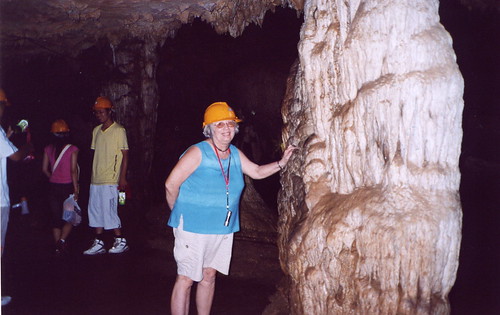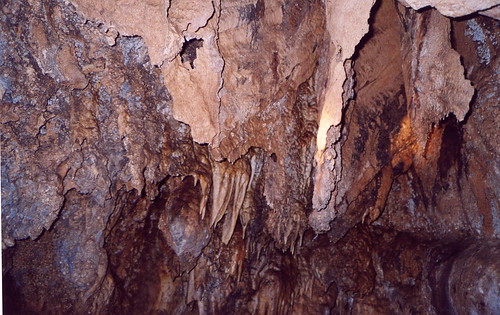Now we're back in Yorkshire, guess it's time to put together an account of our caving in Yangshuo. For those of you who don't know, Yangshuo is a small town a few miles south of Guilin on the Lijiang (or Li river) in Guangxi Province, China. The area is heavily eroded limestone eaten away to form hundreds of those curiously shaped steep-sided hills that make up the local scenery and are a common item in Chinese paintings. There are lots of caves in the area - one in every hill, so they say - so the biggest problem for us was finding some that we could get into (and out of again)...

Some friends had recommended the "Moon Water Cave" but when we asked the receptionist at our hotel how we could get there, were told "Aiya! That is for young people!" Nevertheless we persisted, and a trip was arranged. This involved a short taxi ride to Moon Village where the ticket office was located (opposite the famous Moon Hill, where an old cave passage has left a big round hole through the top of the hill that looks like the moon). Then followed a very interesting fifteen-minute ride in a sort of small minibus along an exceedingly rough unmade road that had our heads bouncing off the roof of the vehicle. Eventually we arrived at a cluster of small buildings at the foot of one of those impossibly steep little hills. This was it!
We got out of the minibus and made our way to the cave entrance - a low, gated archway with a stream coming out of it. There were only a few of us - my wife and I, and three Chinese tourists - but we were provided with site helmets and encouraged to get into a rather wobbly flat-bottomed boat which our guide proceeded to pole into the cave. At first the passage was low enough to make us lie flat in the boat, but as the roof began to rise we were able to sit up and look round and after a little while we came to a point where we left the boat made our way along a level path beside the river. The whole cave was lit by electricity, but rather sparingly: small bulbs placed at wide intervals allowed the visitor to make his way along the paths without fear of getting lost and to get some idea of the size of the place, which was big, but the place was not floodlit like so many show caves. The paths were reasonably smooth and level on the level, but before long we found ourselves going up and down an awful lot of steps as the path led from one vast chamber into another. Some of the steps were of stone, but quite a few were of wood on a metal framework and creaked alarmingly under my weight!
So followed an hour and more of climbing and descending, gazing into the gloomy depths of vast chambers or admiring such of the stalactites and stalagmites as our guide chose to illuminate with his torch or we were able to examine by the light of ours. Our attention was drawn to the usual sort of thing - oddly-shaped stalagmites which were described as "monk making love to his mistress" or "Qu Yuan diving into the river" - while some interesting stal formations and impressive columns were left unmentioned - presumably because they didn't look like anything...? At one point the path had been driven through a massive stalactite curtain, and there were lots of columns decorated with the "bunch of bananas" type of formation that seems very common in these parts.
Margot by one of the many columns in the cave
Formation called "The Butterfly"
(OK, it doesn't look much like anything in this picture, but the two converging curtains do look a bit like a butterfly's wings...)
The cave seemed to consist mostly of a series of large chambers, with a lot of climbing to get from one to the next, followed by some walking-height river passage. There was only one place where we really had to stoop to get through, where a wooden bridge carried us over the streamway and under a low bit of roof, and that was only for a few yards. The highlight of the trip for our Chinese companions was the 'mud bath' where a large pool of liquid mud lay beside the path. Changing tents had been set up in the chamber, together with a desk complete with computer and printer so that digital pictures of mud-covered cavers could be instantly produced and printed out! We left our younger companions to enjoy themselves there, and proceeded with our guide along a further stretch of river passage - slightly reminiscent of the old 'five arches' in Peak Cavern - until we came to the 'big jellyfish', a large stal formation. At this point we had been going for well over an hour, so we turned and retraced our steps to the exit. Our three companions were still messing about in the mud, so it was just the two of us who exited with the guide, some two and a half hours after going in.
An excellent morning for a couple of old 'uns who had not been underground for a few years.

Just a pity my digital camera was refusing to work...


 )
) 



